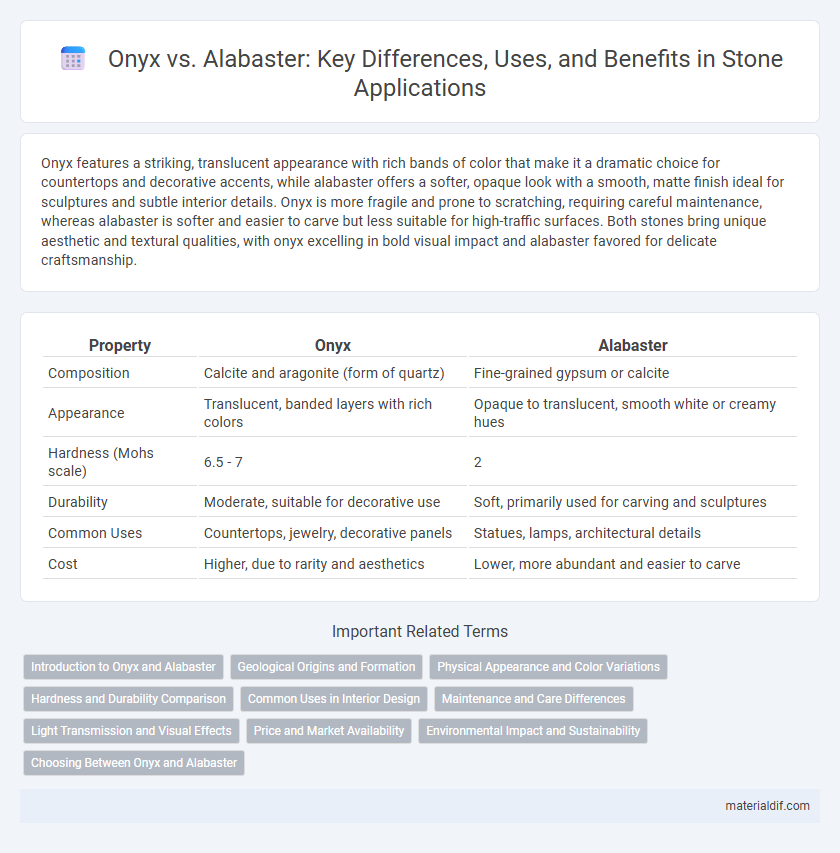Onyx features a striking, translucent appearance with rich bands of color that make it a dramatic choice for countertops and decorative accents, while alabaster offers a softer, opaque look with a smooth, matte finish ideal for sculptures and subtle interior details. Onyx is more fragile and prone to scratching, requiring careful maintenance, whereas alabaster is softer and easier to carve but less suitable for high-traffic surfaces. Both stones bring unique aesthetic and textural qualities, with onyx excelling in bold visual impact and alabaster favored for delicate craftsmanship.
Table of Comparison
| Property | Onyx | Alabaster |
|---|---|---|
| Composition | Calcite and aragonite (form of quartz) | Fine-grained gypsum or calcite |
| Appearance | Translucent, banded layers with rich colors | Opaque to translucent, smooth white or creamy hues |
| Hardness (Mohs scale) | 6.5 - 7 | 2 |
| Durability | Moderate, suitable for decorative use | Soft, primarily used for carving and sculptures |
| Common Uses | Countertops, jewelry, decorative panels | Statues, lamps, architectural details |
| Cost | Higher, due to rarity and aesthetics | Lower, more abundant and easier to carve |
Introduction to Onyx and Alabaster
Onyx is a banded variety of chalcedony known for its striking parallel layers of black and white, often used in jewelry and decorative artifacts for its durability and elegant appearance. Alabaster, a fine-grained form of gypsum or calcite, is prized for its soft, translucent qualities and ease of carving, making it a popular choice for sculptures and ornamental objects. Both stones offer unique aesthetic and physical properties, with onyx providing hardness and bold contrast, while alabaster delivers softness and luminous beauty.
Geological Origins and Formation
Onyx forms through the deposition of silica in cold water environments, creating banded chalcedony layers primarily composed of quartz. Alabaster originates from the alteration of gypsum or calcite in sedimentary environments, resulting in a fine-grained, soft stone with a smooth texture. Both stones exhibit distinct geological origins: onyx as a silica-based mineral from volcanic and sedimentary processes, alabaster as a calcium sulfate or carbonate mineral derived from evaporite deposits.
Physical Appearance and Color Variations
Onyx features a banded structure with parallel layers in colors ranging from black, white, and brown to green and red, creating a striking visual contrast. Alabaster is distinguished by its translucent, milky white or pale pastel hues, often with a smooth, uniform texture that enhances its ethereal appearance. The glossy, high-contrast patterns of onyx make it ideal for bold design accents, while alabaster's soft, diffuse light transmission suits delicate, decorative applications.
Hardness and Durability Comparison
Onyx exhibits a hardness of 6.5 to 7 on the Mohs scale, making it significantly more resistant to scratches and wear compared to alabaster, which scores around 2. This superior hardness translates to greater durability for onyx, suitable for applications requiring resilience such as countertops and architectural elements. Alabaster, being softer and more porous, is more prone to scratches and damage, often best reserved for decorative objects and indoor use.
Common Uses in Interior Design
Onyx is frequently used for decorative accents in interior design, such as backlit wall panels, countertops, and luxury fireplace surrounds, due to its translucency and dramatic veining. Alabaster is commonly favored for sculptures, light fixtures, and window panels because of its soft glow and ability to diffuse light gently. Both stones enhance aesthetic appeal but serve distinct functions based on their optical properties and durability in interior applications.
Maintenance and Care Differences
Onyx requires gentle cleaning with a soft cloth and pH-neutral cleaners to prevent etching and surface damage due to its calcium carbonate composition. Alabaster, being softer and more porous, demands more cautious handling, avoiding water exposure and using mineral oil to maintain its translucency and prevent drying or cracking. Regular sealing is advisable for both stones to enhance durability and resist stains, with onyx benefiting from more frequent maintenance because of its higher susceptibility to scratching.
Light Transmission and Visual Effects
Onyx exhibits superior light transmission compared to alabaster, allowing its translucent layers to glow vividly when backlit, creating dramatic visual effects ideal for decorative applications. Alabaster offers a softer, more diffuse light diffusion, resulting in a gentle, matt glow that enhances subtle ambiance without intense brilliance. The distinct crystalline structures of onyx produce sharp, contrasting patterns under light, while alabaster's finer grain yields uniform translucency with understated elegance.
Price and Market Availability
Onyx typically commands a higher price in the market due to its unique translucent appearance and rarity compared to alabaster. Alabaster is more widely available and affordable, making it a popular choice for sculptures and decorative items with a softer, matte finish. Market availability favors alabaster in regions with abundant gypsum deposits, whereas onyx remains limited mostly to specific geological sources, affecting its price and accessibility.
Environmental Impact and Sustainability
Onyx and alabaster differ significantly in their environmental footprints, with alabaster generally being more sustainable due to its abundant natural deposits and lower energy extraction processes. Onyx mining often involves more intensive quarrying techniques that can lead to habitat disruption and higher carbon emissions. Choosing alabaster supports reduced ecological damage and promotes responsible material sourcing in the stone industry.
Choosing Between Onyx and Alabaster
Choosing between onyx and alabaster depends on durability and appearance preferences; onyx is a hard, translucent stone with striking veining, ideal for decorative features requiring strength, while alabaster is softer and more porous, offering a smooth, matte finish suited for intricate carvings and indoor applications. Onyx's natural translucency allows light to pass through, creating dramatic backlit effects, whereas alabaster's uniform texture provides a subtle, elegant glow without translucency. Consider environmental exposure and maintenance needs, as onyx is more resistant to scratching and weathering compared to the delicate, easily scratched alabaster.
Onyx vs Alabaster Infographic

 materialdif.com
materialdif.com